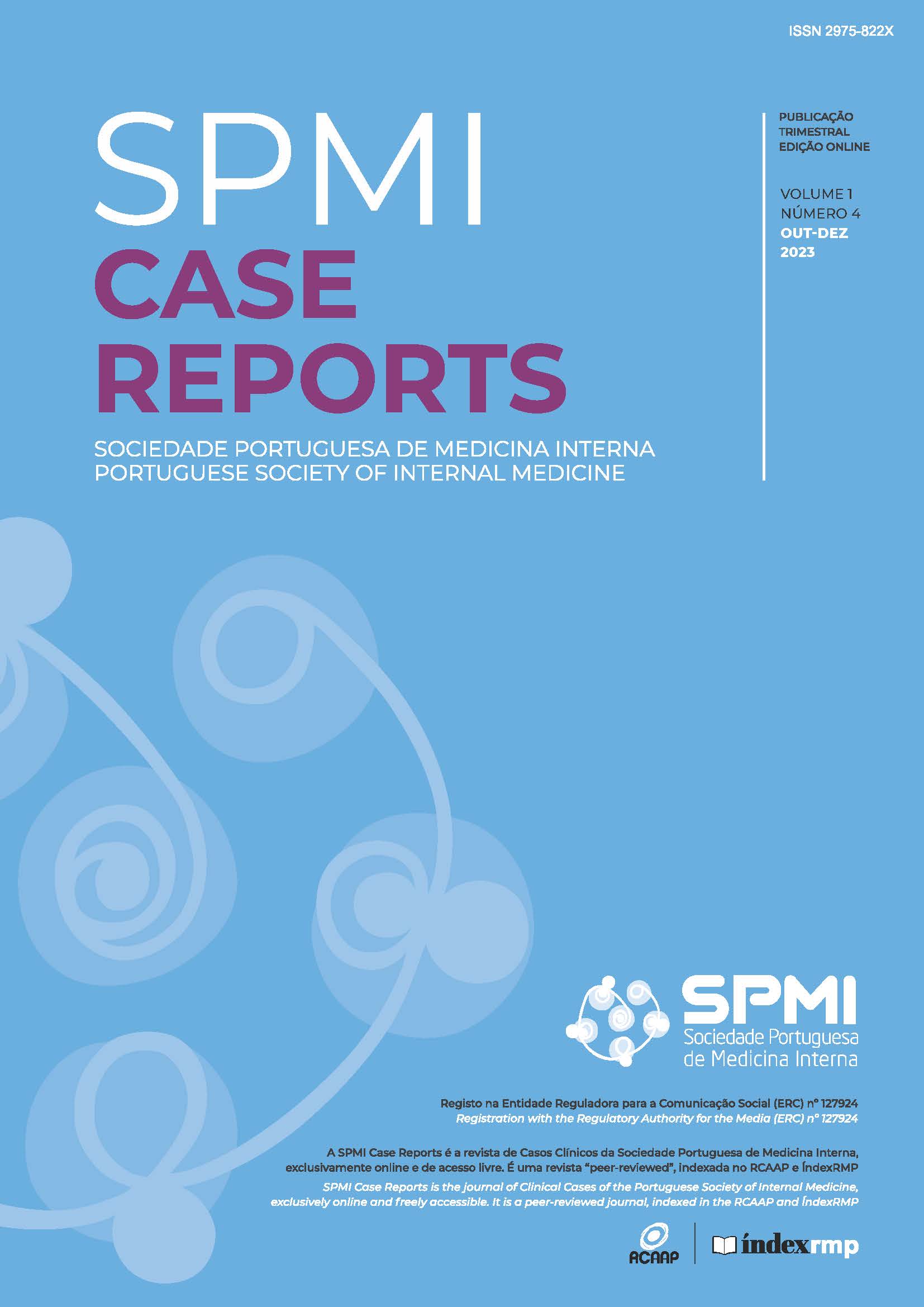Holster Sign and Flagellate Erythema as Initial Presentation of Severe Dermatomyositis
DOI:
https://doi.org/10.60591/crspmi.40Keywords:
Dermatomyositis/diagnosis, Dermatomyositis/drug therapy, Erythema/etiologyAbstract
Dermatomyositis (DM) is an idiopathic inflammatory myopathy. We describe a case of DM with rare skin manifestations.
Women, 35-years-old, came to emergency department with pruritic erythema and muscle weakness. Physical examination: poikiloderma on the lateral thights (hyperpigmentation, well delimited, hyperkeratosis), compatible with Holster sign; skin lesions compatible with Gottron papules, Gottron sign, V sign and inframammary flagellate erythema; myopathic gait. Elevation in creatine kinase, myoglobin, aminotransferases, aldolase and lactate dehydrogenase. Electromyography: myopathy. Magnetic resonance of thighs: myositis. Muscle biopsy: areas of ischemic necrosis. Skin biopsy: interface dermatitis. A diagnosis of DM was made, with cutaneous and muscle involvement. The patient was treated with glucocorticoids and methotrexate, with improvement. After 3 weeks, relapse with severe dysphagia and dyspnea with interstitial lung disease.
Initially, the diagnosis was difficult because of the presence of Holster sign and flagellate erythema, rare skin manifestations, but compatible with dermatomyositis.
Downloads
References
Marvi U, Chung L, Fiorentino DF. Clinical presentation and evaluation of dermatomyositis. Indian J Dermatol. 2012;57:375-81. doi: 10.4103/0019-5154.100486
Malik A, Hayat G, Kalia JS, Guzman MA. Idiopathic inflammatory myopathies: clinical approach and management. Front Neurol. 2016;7:64. doi: 10.3389/fneur.2016.00064
Cobos GA, Femia A, Vleugels RA. Dermatomyositis: An Update on Diagnosis and Treatment. Am J Clin Dermatol. 2020;21:339-53. doi: 10.1007/s40257-020-00502-6.
Bogdanov I, Kazandjieva J, Darlenski R, Razvigor, Tsankov N. Dermatomyositis – Current Concepts of Skin and Systemic Manifestations. Clin Dermatol. 2018; 36:450-8. doi: 10.1016/j.clindermatol.2018.04.003
Orphanet [homepage na Internet]. Paris: Institut national de la santé et de la recherche médicale;1997 [consultado 02 Nov 2022]. Disponível em: http://www.orpha.net.
Ortigosa L, Reis V. Dermatomiosite. An Bras Dermatol. 2008;83:247-59. doi:10.1590/S0365-05962008000300010
Callen JP, Wortmann RL. Dermatomyositis. Clin Dermatol. 2006;24:363-73. doi: 10.1016/j.clindermatol.2006.07.001.
Lam C, Vleugels R. Management of cutaneous dermatomyositis. Dermatol Ther. 2012;25:112-34. doi:10.1111/j.1529-8019.2012.01491.x
Bohan A, Peter JB. Polymyositis and dermatomyositis. N Engl J Med. 1975;292:344-7. doi: 10.1056/NEJM197502132920706
Lundberg IE, Tjärnlund A, Bottai M, Werth VP, Pilkington C, de Visser M, et al. EULAR/ACR classification criteria for adult and juvenile idiopathic inflammatory myopathies and their major subgroups. Ann Rheum dis. 2017;76:1955-64. doi: 10.1136/annrheumdis-2017-211468
Cooper S, Schwarzenberger K, Jones C, Stephens D. The holster sign: an overlooked cutaneous finding in the diagnosis of dermatomyositis. J Arthritis. 2015; 4:1-3. doi: 10.4172/2167-7921.1000145
Parodi A, Caproni M, Marzano A, Simone C, Placa M, Quaglino P, et al. Dermatomyositis in 132 patients with different clinical subtypes: Cutaneous signs, constitutional symptoms and circulating antibodies. Acta Derm Venereol. 2002; 82:48-51. doi: 10.1080/000155502753600894
Malcata A, Queirós V. Anticorpos antinucleares. Acta Reumatol Port. 1988;13:163-73
Alenzi FM. Myositis Specific Autoantibodies: A Clinical Perspective. Open Access Rheumatol. 2020;12:9-14. doi:10.2147/OARRR.S231195
Quain RD, Werth VP. Management of cutaneous dermatomyositis. Am J Clin Dermatol. 2006;7:341-51. doi: 10.2165/00128071-200607060-00002
Downloads
Published
How to Cite
Issue
Section
Categories
License
Copyright (c) 2023 Inês Pintor, João da Costa Oliveira, Ana Isabel Paiva Santos, Pedro Lopes

This work is licensed under a Creative Commons Attribution 4.0 International License.







